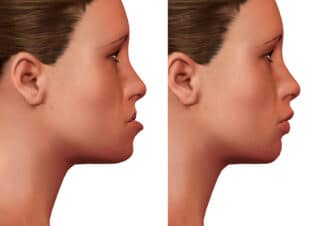
Northern Virginia Surgical Arts
611 South Carlin Springs Road
Suite #308
Arlington, VA 22204
Northern Virginia Surgical Arts
7230 Heritage Village Plaza
Suite #101
Gainesville, VA 20155
Northern Virginia Surgical Arts
9110 Railroad Drive
Suite #100
Manassas Park, VA 20111
Northern Virginia Surgical Arts
361 Walker Drive
Suite #202
Warrenton, VA 20186
OPENING SOON! Northern Virginia Surgical Arts
9001 Digges Road
Suite #102
Manassas, VA 20110

More Dental Health Articles
Orthognathic/Jaw Surgery

When the Jaws Don’t Align Correctly
Some patients have significant over and under bites that cannot be corrected with orthodontics alone. This is when orthognathic surgery is indicated to align the jaws correctly. Teeth are straightened with orthodontics and jaw surgery is performed to reposition and properly align the jaw. Most patients don’t even have to wired shut after surgery anymore. This helps to improve facial appearance, proper alignment of the jaws and functionality of the teeth.
Who Needs Orthognathic Surgery?
For those who may suffer from improper bites or jaws that are malpositioned, orthognathic surgery might be a solution. As a child develops, sometimes the upper and lower jaws grow at different rates creating misalignment of jaws. This can affect chewing, speech, long-term oral health, and appearance.
Orthodontic treatment corrects bite problems involving the teeth; however orthognathic surgery will be necessary to re-position the jaw if the misalignment is too severe to be corrected by orthodontic treatment alone.
Certain conditions to evaluate if they persist are:
- Difficulty in chewing, biting, and swallowing
- Speech problems
- Chronic jaw or TMJ pain
- Open bite
- Protruding jaw
- Breathing problems
Preparation For Orthognathic Surgery
A team approach consisting of the general dentist, orthodontist, and oral and maxillofacial surgeon is essential to the successful outcome of the surgery. The general dentist will help maintain the health of the teeth and gums. The orthodontist will perform pre-surgical orthodontics to level the arches and align the teeth correctly in each jaw. By removing the dental compensations, the degree of skeletal defect is better realized and the surgical planning can then proceed. A post-surgical orthodontics is still required for final correction of the teeth positions.
The doctors at Northern Virginia Surgical Arts use the newest technology to assist with the planning and execution of the procedure. Three-dimensional imaging using an office CBCT and digital models are used to virtually plan the surgery. Surgical guides, splints, and even custom titanium plates can then be printed and used in the operation for optimal results.
Surgical Procedure
Orthognathic surgery is performed in the hospital under full general anesthesia lasting 2-6 hours depending on the complexity of the surgery. After surgery, most patients are observed overnight and sent home the next day. The maxilla (upper jaw) is separated then moved as one or more pieces and fixated in the planned position using small titanium screws and plates. The mandible (lower jaw) is split or separated in the back (ramus) then moved forwards or backwards and fixated using titanium screws and plates. All the incisions are done inside the mouth so there are no scars on the face. The chin can also moved to increase or reduce the prominence and fixated with titanium screws and plates. Pain is controlled with NSAIDs and mild opioid analgesics. Most patients require a one to two week recovery period.
Other Articles You May Find of Interest...
- Let’s Smile Dental’s 7&Up Club
- Strengthening Smiles: Understanding the Importance of Splinting Periodontally Involved Teeth
- Understanding Soft Tissue Grafting: A Key To Periodontal Health
- New Solutions for Dentures and Dental Implants
- How New Tech In the Dental Office Benefits You
- Cerec Dental Technology
- Commonly Treated Orthodontic Problems

















